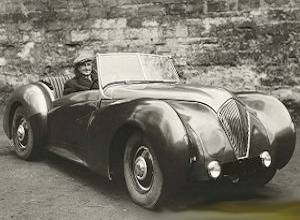With gas strictly rationed, and most new cars earmarked for export, motoring was difficult in 1940s Britain. So when news broke that Donald Healey’s sporty new 146ci (2,400cc) had recorded a best speed of 111mph (179kph) on the Jabbeke Highway in Belgium in 1947, it was especially uplifting news.

Healey 2,4 liter 1946
- YEAR REVEALED 1946
- PLACE OF ORIGIN Warwick, Warwickshire, UK
- HISTORICAL STATUS production car
- ENGINE four-cylinder, 146ci (2,400cc)
- MAXIMUM POWER 104bhp
- LAYOUT front-mounted engine driving the rear wheels
- BODYWORK two-door Elliot four-seater saloon or Westland tourer
- TOP SPEED 111mph (179kph)
- NUMBER BUILT 165
Here was something Britain could be proud of: the world’s fastest production sedan and, hopefully, a taste of good times to come. Donald Healey, exuberant pre-war rally driver and Triumph technical director, had come up with a totally new car. Its light, but rigid cruciform-braced chassis featured advanced front trailing link suspension and was powered by an excellent Riley twincamshaft, twin-carburetor engine.
Initially there were two models: the open Westland and Elliot sedan, both with hallmark kite-shaped grilles and bodies in “Birmabright” aluminum over an ash wood frame. Healey and other contemporary drivers campaigned the cars with panache in great events, such as Italy’s Mille Miglia, in which one won the Touring Car class in 1948. Healeys didn’t come cheap.
The £2,725 luxurious Elliott, inflated by double Purchase Tax because the basic car cost over £1,000 (actually £1,750), put it beyond the reach of all but a few. There were later variations on the original 146ci (2,400cc) cars, but after rights to the Healey 100 were sold to the British Motor Corporation in 1952 (becoming the Austin-Healey 100/4), Healey as a separate marque was wound up.